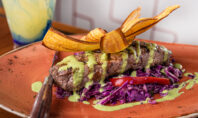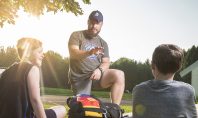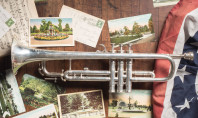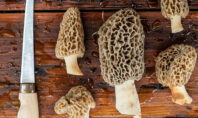The Handman
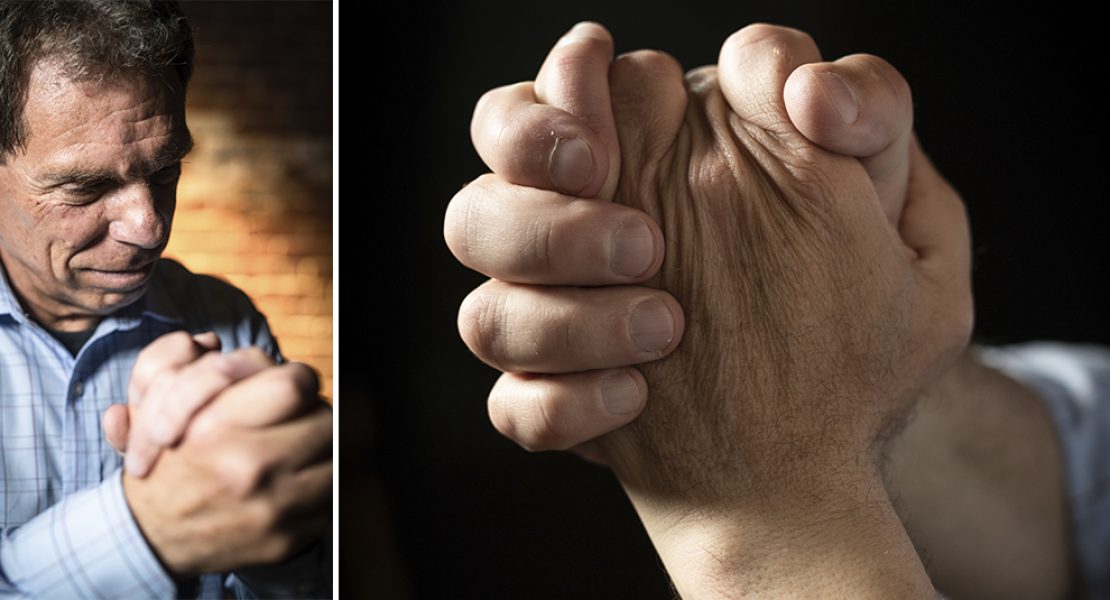
For Bruce Gaston, music is a labor of love. Manual labor. Gaston, also known as Mr. Handman, is among the best known of a handful of manualists—musicians who make music by squeezing air through their hands—having been featured on CNN, NPR, “The Tonight Show with Jay Leno,” “America’s Got Talent,” Germany’s “Das Supertalent,” and numerous radio shows.
The son of a music teacher, Gaston began studying violin at an early age. In high school, when he heard a friend make music with his hands, he was determined to learn that “instrument” as well. He began teaching himself, learning by trial, error, and practice. Lots of practice. “It was three years before I could actually play a song that I thought sounded pretty good,” he recalls, noting that it took time to develop the manual dexterity necessary to make and control the sound. “Then I started to work on the vibrato. The vibrato took 15 years. There are other people who play their hands, but I don’t think anybody does vibrato like I do. I spend a lot of time practicing.”
The Allen Township resident stops talking and demonstrates, earning the attention of his Lab, Sandy. He does much of his practicing while walking her, her leash on his wrist, to free his hands. The clasp must be airtight, he says; he then squeezes his hands together, pushing out air. The fleshy part between the index finger and thumb functions as the “tone maker,” he explains. The sound is novel, slightly humorous, but surprisingly lyrical, especially as he adds the vibrato.
“The real challenge is intonation,” he says, adding that the hands, like other instruments, are affected by the weather, especially humidity. While nervous energy can give a musical performance a positive edge, sweaty palms are the last things a manualist needs. Extreme dryness can also be a problem. “There has to be a certain amount of humidity,” he says. “I’ve played Musikfest when it’s 95 degrees, and it really compromised the tone quality. Part of the art of this is to know what to do to make the tonal quality most beneficial. That’s taken many years.” One of his tricks of the trade is antibacterial gel, which moistens the hands but dries quickly. “And it has an extra benefit. My hands are clean. I can go eat after playing.”
“You can spend all your life playing your hands and just trying to get all the notes in tune,” he says. “If it’s out of tune, it might still be humorous, but I don’t like it.” Gaston, who retires this month as a special education teacher, is looking forward to spending more time with his music—both his violin and his hands. He plays violin in Lehigh Valley pit orchestras and churches, including his home church, where his wife, Betsy, is the choir director. He plays his hands solo at banquets and private celebrations. And, with his partner, Ken Purcell, he alternates between violin and hands. Purcell, who sings and plays piano and guitar, is an experienced manualist accompanist. Gaston’s hands have a range similar to a trumpet. He tunes his notes by ear, and Purcell “does something to get in there.” Gaston and Purcell’s CD, “Mr. Handman, Amazing Feats on Musical Hands,” features their unique collaboration.
“We try not to put too much emphasis on the hands,” he says. “It really gets the attention, but if someone is hearing it for the first time, it’s best to play for only a few seconds, because then they start talking. The violin is the legitimacy, and the hands are the novelty, not to say that the hands aren’t legitimate.”
His hands have legitimately brought him more than 15 minutes of fame. A CNN feature story in 1996 sparked several years of live performances, via phone and on radio stations across the country. With Philadelphia manualist Jim Rotondo, billed as The Four Squeezins, he has appeared in a number of videos, now available on YouTube. The two also appeared twice on “America’s Got Talent” and, in 2001, with a hand whistler, as The Three Tendons, on the “Tonight Show With Jay Leno.” He even performed the processional for an on-air wedding on the final episode of MTV’s “Oddville.”
But despite his success, Gaston is looking to the future. “I’ve been doing this on the side,” he says. “Now it’s time to take it to the next level. I’m retiring, but I’m just starting out with music.”
Hearing is believing! Check out our exclusive video of Bruce performing!
For more information about Bruce visit handman.com; or email handmusik@aol.com.
A MANUALIST MANUAL
So, how do you learn to play your hands? Gaston offers this advice:
“Start working with your hands to get the sound, then listen to a song and try to play that song, to match the pitches. It’s hard to figure out how to get different notes at first. When people try it initially, they don’t have the flexibility in their hands. It takes time.
“And try not to get frustrated. When I started, I was enamored. I’d walk around playing all the time. I remember my dad saying to my mom, ‘He’s always doing that.’ You have to be a little compulsive.”


